Porcelain Insulator News
by Jack H. Tod
Reprinted from "INSULATORS - Crown Jewels of the Wire", November 1974, page 13
Preferably direct porcelain news items and questions directly to Jack H. Tod,
3427 N. 47th Place, Phoenix, Ariz. 85018. All mail will be answered if reply
stamp is enclosed, and the most newsworthy items and questions of general
interest will be published as space permits.
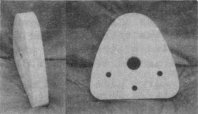
Dear Jack:
I'm enclosing photo of an unusual insulator I got recently from a friend who
has them lining his driveway. It's 8-1/4" across, 8-1/8 high and
1-1/2" thick. It is unglazed, unmarked. I have no idea what is was used for
and thought perhaps you could give me some information on it. Any ideas would be
most helpful.
Dean Axelson,
Willowdale, Ont., Canada
- - - - - - - - -
Dear Dean:
No ideas, but a suggested starting point would be to ask your friend with the
driveway. It "smells like" an electrical item, but I wouldn't book
money on it. Can any of you readers identify this thing? Meanwhile, this would
be a handy item to have around the house in case you ever get real mad at your
wife.
Jack
Our editor, Dora Harned, bought this early Locke from N. R. Woodward at the
Hutchinson 1973 National show, and I finally got around to getting it drawn up
while visiting the Harneds prior to the Oroville, Cal. show.
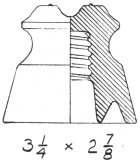
Gary Cranfill showed up with another one at the Oroville show, but I lost a
foot race trying to get it for my collection.
This in the usual tan-carmel glaze, and it is marked "F. M. LOCKE,
VICTOR, N.Y." on the skirt (no date). Dora's specimen has four small
protrusions on the crown top, but the one Gary had did not have these. I don't
know what their purpose was. The specimens were fired on their base rim.
This in an early Locke classic, the forerunner to the modern Locke #2, and
it's a style chart addition.
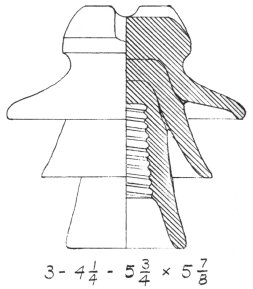
Larry Thomas (Oroville, Cal.) turned up the 3-piece glazeweld shown at the
right and which is a new one for the style chart.
Judging from characteristic styles cataloged by Thomas in the early 1900's,
this could be a Thomas item.
The origin of this specimen was tracked back to an old line in Nevada, and it
was said this one was saved as a souvenir when the line was taken down and that
all its brothers were pitched down an old mine shaft.
Larry also showed me the insulator at bottom right here, and this is a very
unusual Fred Locke piece. Note the 1- 3/8" pin hole and how the inner
section is flared out at the bottom to accomodate the larger pin hole.
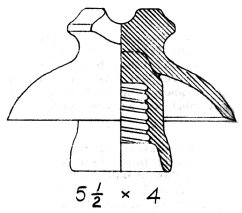
One side of the skirt has a 3-line (4 dates) wordy Fred M. Locke marking; the
other side has the VICTOR tradename and the DEC 4 '00 manufacturing date.
This is undoubtedly the earliest version of the Locke #298 which was first
cataloged in 1902 and then specified as made all in one piece. The design
persisted to modern times but in more streamlined shapes such as the U-670
series in the style chart.
To cap things off, Larry also reports having Imperial items with the error
PORCELANN in the #3 Imperial handstamp marking device. These are also dated in
the April 1900 period, and this must certainly set some sort of record for
errors in handstamp markings by Imperial.

Dear Jack:
... I also have the following radio lightning arrestor which I haven't seen in
your past listings of dry process markings in Crown Jewels. I can't make out the
first letter in the company name on it. Any information would be appreciated.
Randy Puchalski,
Chicago
- - - - - - - - - -
Dear Randy:
Yep, this is a new one, but I can't locate this in any of my files or
directories. A reader may fill us in on it. These arrestors are interesting to
collect as they all are marked with radio company names, whereas the small
strains were rarely marked.
Jack
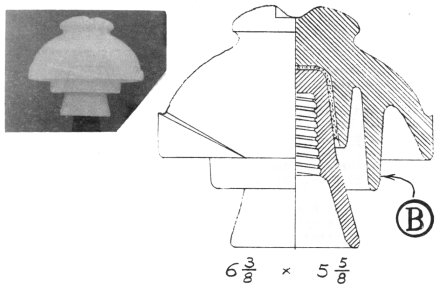
Dick Alumbaugh, Anaheim, Cal. reports having the insulator pictured here. It
has a marking stamp hit five times around the outside of the extended petticoat
of the upper piece, and the faint marking appears to be a Circle-B or Circle-3.
Note the shallow eaves around the edge very similar to those on the U-937
made by Imperial for Fred Locke. Not having seen this insulator in the flesh, I
wouldn't care to hazard a guess as to which company made it. Dick did not
indicate the origin of the specimen.
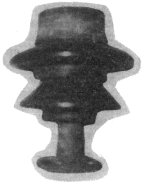
Dear Jack:
... Also, I got three large Locke insulators with large metal bases and top caps
(shown at the right) ....
Are you going to include Lapp "Posts" in one of your books? So far
I have 4 of these. I know they're pretty new, but they are a pin type you could
say. My 1959 Lapp catalog shows about 10 pages of different posts.
I recently received a U-634A, and definitely a Lapp. The only marking was an
incuse A on the skirt. Any ideas on this?
Ed Allandar,
Duncannon, Pa.
- - - - - - - - -
Dear Ed
Your large Locke with metal post and metal cap is a standard type of
"switch and bus" insulator, and you can see these in great profusion
at any utility substation in your neighborhood.
No, nothing is in the works for any publication which would cover line post
insulators. And no, "pin types" are industry defined as insulators
which are screwed onto the crossarm pins. "Posts" are thus not pin
types.
The incuse A on your U-634A is a trimmer operator identification stamp, and I
have seen other letters on U-634A and other Lapp pin types. See page 13, April
1974 Crown Jewels for more info on these markings.
Jack
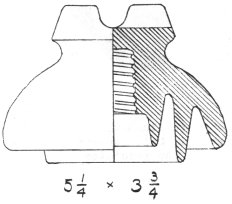
I got this white crosstop at the Oroville show. Although it in similar in
style to the U-923A and U-923B, there is one great difference. This one is a dry
process specimen! Note the sharp crown features and the deep top grooves. It is
a Top Rest.
Too bad it has no markings. I suspicion it was made by either Peru Elec. Mfg.
Co. or General Electric Co. in the early 1890's.
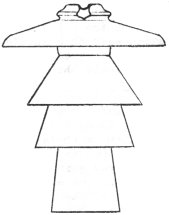
Ed & Judy Gish (Houston) have another interesting multi, as sketched at
right. The top shell has a wordy Fred Locke stamp with a number of patent dates,
and the bottom shell is stamped with yet another Fred Locke marking.
The top shell is the early tan glaze, and the three bottom parts are a
reddish brown. The middle two parts have factory identifier part numbers on the
undersides. This insulator is 18" tall and the top shell measures
14-1/2" across.
They also report having a cross top similar U-927B with a Fred Locke
underglaze marking (blue ink). This one is the usual Locke tan color but with a
blue-black sheen. Nice, eh?
Ref page 18, Sept 1974 issue Crown Jewels, regarding McGraw-Edison (Macomb,
Ill.) now using an underglaze marking for light glazes but retaining the
sandblast marking for the darker glazes, here is additional information.
Dear Jack:
... Our dark colored glazes have become such a minute part of our business we
have not pursued any development for stamping inks for them. We do have a
problem with a good legible stamp on light glazes (blue-gray glaze). Most of
this is a hand operation with an ink pad and rubber stamp.
Too much ink, not enough ink, drying on or sticking to stamp, and applying
the stamp to the ware to make a full and complete stamp in a legible manner all
contribute to the problem....
John R. Stout
Product & Process Engineering
Manager
McGraw-Edison, Power Systems Division
Rollo McDonald (Mississauga, Ont.) put me onto this interesting Insulator and
sent preliminary info.
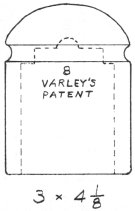
Then,
Dear Jack:
Received the letter you sent Rollo regarding my Varley's Patent insulator.
It's a real oddball, as it is much larger than any telephone insulator in my
collection. I believe it was found on a C.N.R. telephone line as I purchased
it from an antique dealer, and he only buys from telephone and telegraph
employees, and won't give me the name of the person or where it came from.
The inside seems too large to fit on any pin except with the fibre liner
(asbestos type material) that doesn't have any threads. The insulator is in
perfect condition except for a wire cut in the groove due to wear from the
tie-wire. It is a mottled light brown partly speckled color and the same light
gray body material that we find on some of our other porcelain beehives.
It appears quite old as the porcelain is rough and the top is pitted.
Allan Banfill,
Richmond, Ont., Quebec
- - - - - - - - -
Can any of you patent digger-uppers help us out on this one? Sure looks
interesting.
Jack
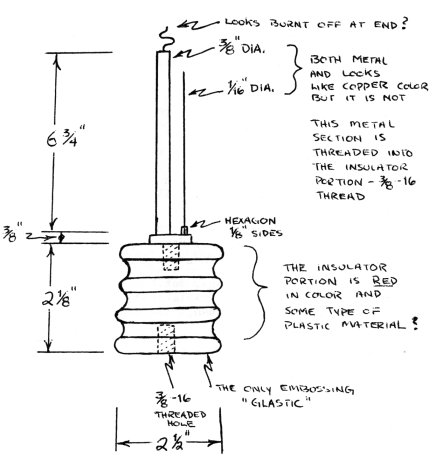
Dear Jack:
I recently found two of these insulators (?). Not sure what they really are,
but the interesting thing is that they are "red" plastic. I was
wondering if you or one of your readers could help me out? The only idea I have
is that they could be some sort of primary fuse for high voltage or lightning
arrestor.
John De Sousa,
NIA #419, Bloomfield, CT
- - - - - - - - - -
Dear John:
No ideas here either, but I have a hunch it's something to do with radio
gear. Any readers know?
Jack
Lew Hohn (Rochester, NY) now has a new insulator shape with the G marking.

It
is similar to U-55 and is a yellowish tan color. (I have a U-236, G with the
same glaze.) Since the G is still our mystery manufacturer's marking like the
Star on glass insulators, we are naturally very interested in any new shapes
that turn up with this marking.
Lew also has an exchange Sim U-58 which has a very clearly embossed
"5" in the top of the pin hole, and he asks how it is possible to get
an embossed number there, and also what it may stand for.
First I've heard of one like this. It would be possible since the thread
pitch (1/4") is so fast, the mandrel would back out very quickly with the
first turning movement when it was retracted. I presume the number was just to
mark the tooling piece, but all the threading mandrels and die parts I have ever
seen at the plants are marked with identifying numbers where they don't contact
the clay.
Dave Ramp (Larwill, Ind.) reports having the insulator shown at the right,
and which is shown on page 5 of the 1902 C. S. Knowles catalog reprint
(available from Frank Peters, $3.00).
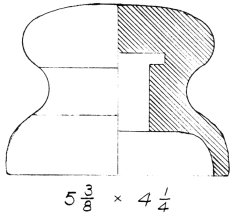
This is the No. 1091 size of the Etheridge patent insulator, and Dave says he
saw a specimen of the smaller No. 1090 at the Hershey show.
This is patent #676,881 of June 25, 1901 by Harry Etheridge, McKeesport, Pa.
for a "Self-locking Insulator and Pin". A tubular steel pin mounts on
the crossarm, and a spring retains the insulator and pin in place. The insulator
can rotate on the pin when in place, and those were cataloged as high strength
assemblies for corner and anchoring applications.
Dave and I agree that, special as it is, this insulator is a "pin
type" for crossarm use and should go into the style chart. Any ideas where
in the chart, though?!
Not to be outdone by others reporting early Fred Locke goodies, Dave has the
one shown at the right, and which is a new chart addition.
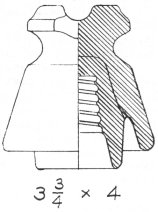
This yellow-brown specimen has two different Fred Locke stamps on one side of
the skirt and a DEC 22 1900 manufacturing date on the other side. The unglazed
firing surface is on the top.
This appears to be a later version of the very earliest Locke #9 (1897) and
is further backup that the indented version of the crown originated in late
1900.
Dee Willett (Bakersfield, Cal.) asks about the ashtray pictured here and
which has an embossed star on its side. The item is made out of a crude
earthenware.

I feel this item is probably not associated with any insulator company but,
if so, it would have to be Mogadore. This company was formerly Akron Smoking
Pipe Co. and made clay smoking pipes given as premiums for the Diamond Match Co.
They used a "Star" trademark later when they made stoneware and
porcelain insulator cleats in the 1890's.
Dee also has a U-388 Roman Helmet which is identical to the Thomas
manufacture of that type, but it has a large incuse "S" stamped in the
top groove and again on the side of the dome. I don't have any idea of what this
marking is, but it probably was a factory control marking indicating a special
run of some sort.
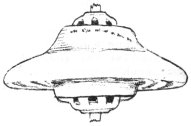
Dear Jack:
... I would appreciate any information you can give me as to who made this
insulator and what value as a collector item. It in 11-1/2" diameter, light
blue glaze and has an underglaze marking "Pat. Feb. 3, 1920 Mfg. Feb.
1924".
John Beres,
Cleveland
- - - - - - - - - -
Dear John:
This suspension insulator was made by the Jeffery-Dewitt Insulator Co.,
Kenova, W. Va. This company was founded in 1915, incorporated in 1922, and
became essentially defunct by 1940 -- but subsequently operated by new owners and
then later by Line Material Co. for one year until it burned completely in 1952.
These suspensions were made between 1915 and the early 1930's. and J-D used
that light blue glaze on all insulators for use on lines nominally 27 Kv and
higher. Your item is their standard suspension made by the millions, but they
also made smaller versions in chocolate brown and with 2-footed spiders instead
of the 8-pointers as on yours. Needless to say, these metal "spiders"
leaded into the holes in each end of the porcelain operated the porcelain in
tension, and that is a no-no in good design. The ensuing unreliability led to
the demise of this company.
Although an interesting design with some historical significance, there just
aren't many serious suspension collectors, and there are plenty of these old J-D
disks lying around salvage yards. I have seen them at shows with price tags in
the $5 to $15 range.
Jack
| 